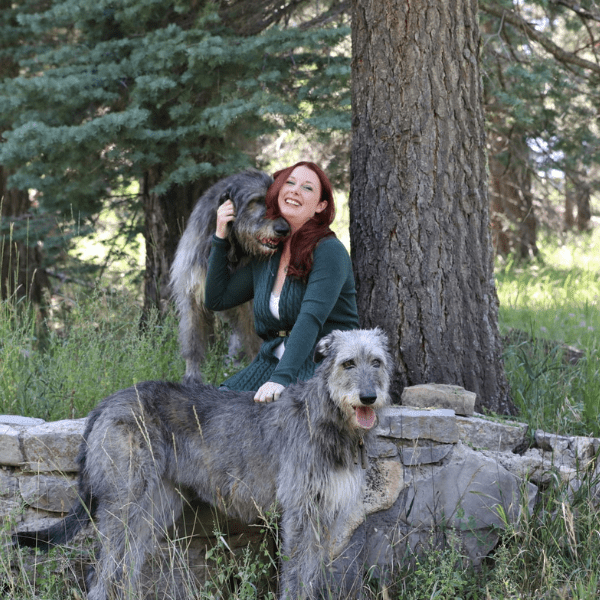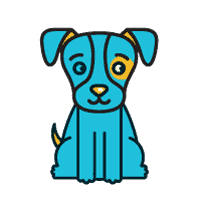April 2025 KPA CTP of the Month: Ellen Schmidt

If you were a dog, what breed would you be?
While I’d love to say I’m as smart, cool, and laid-back as my heart hounds, Irish Wolfhounds, I think I’m probably more like a Scottish Collie. I love to work, can be a little drivey, and like things in order. I’m also deeply dedicated to my family and enjoy making those around me feel happy and safe. Though I love my work, I’m still pretty good at kicking back.
What is your favorite activity or sport that you do with your own dog(s)?
I have two equal passions when it comes to activities with my dogs (beyond the pure joy of being out in nature with them): scent work and “therapy” work. I adore scent games and using clicker training in scent work. All my dogs have loved scent work, and I get so much joy from watching them engage in something so purely and genuinely dog! And when I have a dog who enjoys it just as much, I love being part of a team that brings comfort and happiness to others through visiting dog work (a/k/a therapy dog work).
Outside of dog training/ dog sports, do you have any hobbies?
I have too many hobbies, honestly. I’m a very dedicated gardener, and my gardens just seem to get bigger every year. I also love to sing, especially traditional Irish and Scottish music, and I’m part of a local Celtic Singers group that learns and performs songs in English, Scots, Irish, Scottish Gaelic, and Welsh. Along those lines, I’m working on learning Scottish Gaelic and learning to play the harp. I deeply love history (my degrees are in history), so I’m constantly reading books and listening to podcasts about my favorite periods and places. And then there’s travel, hiking, archery…the list goes on!
When did you start training, and how has the industry changed since you started training?
I started assisting with training classes in 2010 and began offering training to the public myself in 2011.
Since then, I’ve seen clicker training go from relatively novel in our city to more commonly known and accepted. When I first began helping with classes, it wasn’t unusual for clients to be utterly unfamiliar with clicker training. Now, people who reach out to Quest for a trainer have almost always at least heard of clicker training, and most are excited to learn more about it. Many have used clickers in classes with their dogs at some point. However, many myths about clicker training—like that it can’t be used for challenging behavior cases or that you always must use food—are still fairly prevalent. It’s not uncommon for clients to struggle with implementing a positive reinforcement approach in their daily lives. Trust me, I’ve been there, and I get it!
I’m also seeing a concerning resurgence of positive punishment approaches (sometimes distressing ones) being repackaged and presented in new ways. More people are getting their training information from quick, short videos on social media rather than formal classes. In our fast-paced world of communication, misinformation spreads quickly, and well-meaning dog guardians looking for help can easily be misled by promises of quick fixes without realizing what these training techniques can do to their dogs and their relationships. All of this only strengthens my desire to help make it as easy as possible for guardians to connect with well-educated trainers who focus on positive reinforcement approaches in whatever small way I can.
How has completing the Dog Trainer Professional program and becoming a KPA CTP changed your life and career?
It is hard to summarize the DTP program's impact on me. I have always deeply cared about the human + non-human animal relationship. I want to treat the animals in my life with kindness, compassion, and respect and bring mutual benefit to each other. While any efforts to use positive reinforcement in our training and communications with others is critical, the DTP program gave me the practical skills and tools needed to make that positive approach something I can do every day, with every interaction. It changed the way I think about interactions and learning, made me more aware of all the things that might be influencing another’s behavior, and more confident in the steps I can take to change the picture if I need to.
It also brought me a fantastic community! I’ve formed lasting friendships with some of the people I went through the DTP program with, and being a KPA CTP has helped me connect with other KPAs in my state. Attending ClickerExpo, surrounded by savvy, wonderful, and like-minded folks, is always a joy.
What do you do to continue your training education?
One of the best things about living in this day and age is how accessible quality education has become! I learn best through listening, so I’m constantly tuning into podcasts, and whenever possible, I love attending training conferences. But I also gain so much from chatting with my fellow positive reinforcement trainers in our little Albuquerque community. Whether through conversations or getting together for drinks and meals, I always discover new approaches and resources, which I love.
Was there a particular dog/animal in your life that was your most important teacher?
I think I’ve learned something from just about every animal I’ve trained, but I always have to come back to my girl Darcy as my most important teacher. Darcy was my first dog, a female Irish Wolfhound. She was amazing— incredibly smart, confident, and maybe even a little more clever than is ideal for a newbie dog guardian. I completely adored her, falling head-over-heels in love. I got her before I started learning to train, so she was with me when I “crossed over” into the positive reinforcement trainer I am today. In fact, she’s the one who taught me just how vital that crossover is!
When I brought her home as a puppy, I knew a little about positive reinforcement training and used it for the basics. But I didn’t understand it enough to problem-solve typical puppy challenges. So, when Darcy grew big enough to pull on the leash, I did what the trainers at our obedience school recommended and used a prong collar. When she started struggling with nail trimming, I did what I was taught from working at a grooming salon and held her down. These approaches didn’t work well and, in fact, made things worse (especially with nail trimming), but I didn’t know what else to do.
While I cringe at these choices now, I’m grateful to say the story has a beautiful ending. A colleague at the animal shelter where I worked helped me take a different approach. The incredible Lisa Gunter (PhD, MA, CBCC-KA, now at Virginia Tech) was our head trainer, and one day, she took the time to help me experiment with a more positive reinforcement-based approach to walking Darcy, getting her off the prong collar. The genius girl that my Darcy was, it took her maybe 15–30 minutes to understand the new structure and game of the walk. After walking her on a prong collar for almost two years, she learned not to pull on a flat collar within a week—once I used a more effective, positive approach!
Nail trimming came next, and building on the ideas Lisa gave me, I started experimenting with positive nail trim training. It took longer, but it worked like a charm! Best of all, I saw my girl’s trust in me and our activities blossom. I loved her so much, and seeing how much better the positive approach made our relationship was incredibly impactful. It was then that I decided I wanted to be a trainer myself. By the time Darcy was 3, I was apprenticing with classes and learning more and more every day.
Darcy became my beautiful demo dog, helping me with puppy classes and joining me at schools where I taught Humane Education programs, including ones focused on positive training approaches. She was my partner when we completed the DTP program, and her perfect performance during our 10-part chain is still one of my proudest moments! Darcy taught me that positive reinforcement training is not only more effective and strengthens the bond between learner and teacher, but it also honors the intelligence and dignity of the incredible dogs we’re privileged to live with.
Do you have any more memorable stories from your time in the DTP?
There are so many memorable stories! My favorite is when my KPA DTP faculty member, Dani Weinberg, helped make the power of clicker training…well, click! I was a moderately experienced trainer when I went through the DTP program and a little set in my ways (can we say Dunning-Kruger?!). During one exercise, where we were supposed to teach our canine partners to back up, I was convinced I knew how to do it—relying on subtle body pressure, a narrow alleyway made from tables, and clicking when Darcy stepped away from me. But, despite my confidence, Darcy was not understanding what I wanted from her.
Dani quietly and gently “flipped the script” by stepping into the back of the alley (opposite where I had been standing) and dropping a treat. Darcy walked into the alley to eat the treat, stepped backward to get out, and Dani clicked and dropped another treat. Darcy moved forward, ate that treat, and stepped back, and Dani clicked again. As Darcy ate the third treat, you could almost see the light bulb above her head switch on. “Ah! That’s what you want!” From that moment on, Darcy began offering bigger and more enthusiastic backward steps while Dani stood quietly, clicking and treating her efforts.
Within a few minutes, Darcy had gone from standing still, confused, and staring at me to scooting excitedly backward just to get Dani to click. It was just that simple. I’ll tell you, that light bulb went on for me, too!
What is the most important piece of advice you can give to a new trainer?
Keep learning. One of the best things about this industry is that you’ll learn something amazing from every client and animal you work with. There’s always more to discover, and you’ll be amazed at how much you’ve grown and changed each year. We get to be lifelong students, and how cool is that?
While you learn, remember the power of compassion. Compassion for the animals we work with, of course, but also for their guardians, for your fellow trainers who may not yet be using the techniques we hope to see used by all but who are earnestly trying to help, and especially for yourself. We are all always learning, which means we continually grow and improve. Compassion for each of our journeys brings joy, which helps us keep going.

We get to be lifelong students, and how cool is that?
While you learn, remember the power of compassion.

How can people connect with you?

